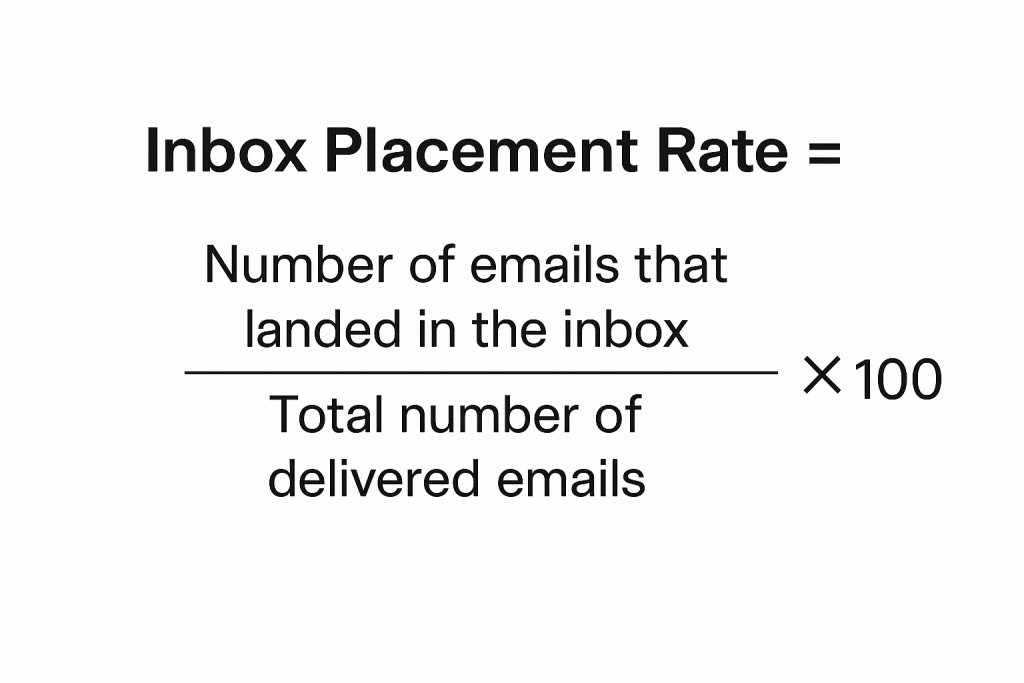- Home
- Email Tips and Tricks
- Fix Your Inbox Placement: Emai ...

Inbox placement is one of the most important contests for email marketers—except instead of gold, silver, and bronze, the prizes are the inbox, promotions, and spam. While getting into users’ inboxes is the ultimate prize, spam is the out-of-contest category that should be avoided by all means.
And yet, every email you send participates in this competition. You don’t always see it, but mailbox providers do. They judge you based on things like your sender reputation, your content, how your audience interacts with you—and then they decide where your email belongs.
In this article, we’re going to look at what inbox placement actually means, why it’s more important than it might seem, and how it differs from simple deliverability. You’ll also learn how to calculate your inbox placement rate and discover inbox placement tools that can help you test and improve where your campaigns end up.
What Is Inbox Placement
Inbox placement is where your email lands once it’s delivered. But not just “delivered” in the technical sense, but where exactly it ends up—the inbox, promotions tab, or spam folder as a worst case. Because, technically speaking, all of those are delivered, but only some actually count as such.
Let’s compare your mailbox to an apartment and your emails to the stuff you bring home. After all, once things cross the threshold, the next big question is, where do they end up?
Some items—like your new abstract painting or your go-to coffee mug—go straight to the living room. That’s your inbox: there, things are visible, accessible, and usually good-looking—that’s why they are used.
Other things, like your laundry detergent or the fifth pair of sunglasses you bought “just in case and to return after,” get tossed into the laundry room or a side drawer. That’s your promotions tab—technically, they are in the house, but out of sight and out of mind.
And then there are the things that you bring to never use again, like wrapping paper—they are slipped into the attic or a cardboard box under the bed. That’s spam. They’re still there, just… not really.
This little role play is a very accurate representation of what inbox placement is about. It’s not just getting your emails delivered but also making sure they end up where they will be noticed and used. And for that you need to make the content of your emails useful or (and) visually striking, and preferably personalized too!
And here’s the thing: inbox placement affects your open rates, your engagement, and your conversions. That’s why more and more marketers are running an inbox placement test before every campaign—just to make sure the email they crafted with love and effort doesn’t end up in the closet (junk drawer).
Inbox Placement vs. Email Deliverability
If inbox placement is where your email ends up, email deliverability is about whether it got through your email gatekeepers, also known as email providers.
If the email doesn’t have the right credentials—maybe it looks suspicious, maybe it forgot its SPF or DKIM—it never gets past the lobby (let’s go on with the apartment example again). It gets rejected, bounced, or blacklisted altogether.
Inbox placement, on the other hand, is what happens after your email is let in. Did it make it to the coffee table in your living room (the inbox), or is it hiding behind the vacuum cleaner in the hall closet (spam)?
You can have great deliverability—meaning your emails were technically “delivered”—and still have poor inbox placement. Why? Because inbox placement is a complex mixture of your reputation, content, and engagement history.
Maybe the subject line was too salesy. Maybe too many people ignored or deleted your previous emails. Or maybe you’ve been sending a few too many lately, and people started clicking Mark as spam to avoid being overwhelmed.
So, the difference between the two can be summarized as follows: email deliverability is about getting in, and inbox placement is about getting seen. For success you need both, and trust us—your open rates will know the difference.
What Is a Placement Rate and How to Calculate It
So, we’ve talked about inbox placement, but how do you actually measure how well you’re doing at it? For that you need a placement rate—the percentage of your emails that land in the inbox (as opposed to spam or promotions), out of all emails that were delivered.
Let’s say you send 10,000 emails, and 8,500 of them land in your subscribers’ inboxes (not in spam, not in promotions). Your inbox placement rate is 85%. It is simple math—but incredibly useful for understanding whether your emails are actually seen.

We’ll talk about tools that can help you to calculate and monitor inbox placement over time in the next chapters.

What Determines Inbox Placement?
While for a regular user inbox placement might seem like a random thing, a game of chance really, for marketers who understand how it works, things look different. The reason some emails go straight to the inbox, while others end up in the promotions tab or even spam, is not luck but a mix of several key factors.
The first one is sender reputation. Here everything boils down to trust—built over time through your recipients past interactions. If people open, click, or reply to your emails regularly, you’re in a good place. But if your emails are ignored, deleted, or marked as spam, that trust erodes—and so does your placement.
Next is authentication. SPF, DKIM, and DMARC are must-haves for every respectable email sender. And with updates like Microsoft’s 2025 email authentication policy, properly setting them up is non-negotiable—especially for high-volume senders.
Then comes engagement history. If users interact with your content often, mailbox providers take it as a good sign that your emails belong in the inbox. If not, you may be redirected elsewhere. Engagement includes the full spectrum of behavior, like forwarding an email, replying, moving it out of the spam folder, or even just spending a bit of time reading it. Providers track these subtle signals and use them to decide whether future emails from you deserve prime placement… or not.
Finally, there’s your sending behavior. If you tend to be a sporadic sender with months of silence and then sudden email blasts, it raises concerns, as it looks unreliable and, thus, suspicious. A consistent schedule and gradual warm-ups are good sending habits that every respectable sender needs to adopt.

Testing and Monitoring Inbox Placement
Inbox placement isn’t something set in stone. It’s not a one-time fix you apply and then forget about. It needs constant attention and readjustment for as long as you are working with emails—which, let’s be honest, might be forever. And here comes the not-so-great part: even if you’re doing everything right, there’s still no guarantee your emails will always land where you want them to.
Because mailbox providers are constantly adjusting their algorithms. What worked last month might be completely outdated today.
That’s why, besides crafting high-quality campaigns, you also need to test them before hitting send. The good news is, there are plenty of tools nowadays that let you run an inbox placement test across different providers like Gmail, Outlook, or Yahoo. These tools simulate your email’s delivery journey and show you where it’s likely to land.
Then comes monitoring. Once your campaign is out there, keep an eye on your open rates, bounce rates, spam complaints, and even reply activity. These metrics are your feedback loop—the way your audience tells you how things are going. And when something unusual spikes, it’s your signal to investigate. Maybe your copy needs updatingt. Maybe your sending frequency needs to slow down. Maybe it’s time to rework your timing.
For better or for worse, inbox placement is a moving target. But with consistent testing and a good understanding of your performance data, staying on track becomes a whole lot easier.
How to Improve Inbox Placement
👉 Run an inbox placement test before sending
Nowadays you can test practically everything, and inbox placement is no exception to this rule. That’s why today more and more marketers use tools like Mailtrap that simulate deliveries across different providers and tell you if your campaign ends in inbox promotions or spam. It’s a low-effort, high-efficiency practice that you should definitely adopt—especially if you are a high-volume sender.
👉 Warm up new domains and IPs slowly
If you are starting from scratch or switching to a new sending domain, start slowly. Email providers don’t trust sudden spikes; rather, they treat them as red flags. Send to your most engaged subscribers first, and gradually increase volume over time.
👉 Segment your list and send smart
Not every email is for everyone. So instead of sending generic content to everyone, break it down into smaller, more targeted groups. Segment by interests, activity, or purchase history—whatever makes sense for your business. This way, your engagement will be better, leading to better inbox placement over time.
👉 Clean your list regularly
High bounce rates hurt your sender reputation. So, scrub your list regularly by removing invalid addresses and unengaged users. Not only does it boost your deliverability and inbox placement rate, but it also saves you money in the long run. Win-win.
👉 Keep subject lines honest and human
We all love a good hook, but misleading or overhyped subject lines are a one-way ticket to the promotions tab—or even spam. Stick to what your email actually says inside. Be clear, honest, and maybe even a little charming. Your subject line is your first impression, so make it positive.
👉 Make unsubscribing easy
As illogical as it sounds, making unsubscribing easy is actually one of the best ways to maintain a healthy email list. It keeps your complaint rates low and shows mailbox providers you respect your recipients. Microsoft, Gmail, and Yahoo all mention this in their recommendations for email best practices for high-volume senders.
To Sum Up
So, what is inbox placement really about? It’s about not just showing up but showing up in the right place.
We’ve talked about inbox placement vs. email deliverability, explored the key factors that influence where your emails end up, answered the question “What is a placement rate and how do you calculate it?” and more.
Now, armed with this knowledge, you have all the chances to see your emails landing in inbox folders. And always remember that inbox placement is never static—so don’t forget to tweak things from time to time.



